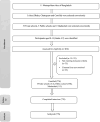Nutritional status, dietary habits, and their relation to cognitive functions: A cross-sectional study among the school aged (8-14 years) children of Bangladesh
- PMID: 38805518
- PMCID: PMC11132469
- DOI: 10.1371/journal.pone.0304363
Nutritional status, dietary habits, and their relation to cognitive functions: A cross-sectional study among the school aged (8-14 years) children of Bangladesh
Abstract
Background: Limited research addressed links between nutritional status, dietary habits, and cognitive functions in young children. This study assessed the status of cognitive functions and their association with nutritional status and dietary habits of school age children of Bangladesh.
Methods: This cross-sectional multi-centre study was conducted on 776 participants in 11 conveniently selected educational institutions. A printed questionnaire with three sections (Section 1: background information, section 2: PedsQL™ Cognitive Functioning Scale, and section 3: semi-quantitative food-frequency questionnaire) was utilized for the data collection purpose. Sections 1 and 3 were self-reported by parents, and trained volunteers completed section 2 in-person along with the anthropometric measurements. Statistical analyses were done in Stata (v.16). Mean with standard deviation and frequencies with percentages were used to summarize quantitative and qualitative variables, respectively. Pearson's chi-square test and Spearman's rank correlation coefficient were used to explore bivariate relationships.
Results: The mean age of the participants was 12.02±1.88 years, and the majority (67%) were females. The prevalence of poor cognitive function was 46.52%, and among them, 66.02% were females. In terms of body mass index (BMI), 22.44% possessed normal weight, 17.51% were overweight, and 5.19% were obese. This study found a statistically significant relationship between BMI and cognitive functions. Furthermore, different dietary components (e.g., protein, carbohydrate, fat, fiber, iron, magnesium) showed a significant (p<0.05 for all) weak positive correlation with cognitive function.
Conclusion: BMI and dietary habits were associated with the cognitive function of young children in Bangladesh. Although the cross-sectional design of the study precludes causal relationships from being determined, the study finding deserves further examination via longitudinal research.
Copyright: © 2024 Liza et al. This is an open access article distributed under the terms of the Creative Commons Attribution License, which permits unrestricted use, distribution, and reproduction in any medium, provided the original author and source are credited.
Conflict of interest statement
The authors have declared that no competing interests exist.
Similar articles
-
Gadget addiction among school-going children and its association to cognitive function: a cross-sectional survey from Bangladesh.BMJ Paediatr Open. 2023 Feb;7(1):e001759. doi: 10.1136/bmjpo-2022-001759. BMJ Paediatr Open. 2023. PMID: 36808098 Free PMC article.
-
[Simple obesity in children. A study on the role of nutritional factors].Med Wieku Rozwoj. 2006 Jan-Mar;10(1):3-191. Med Wieku Rozwoj. 2006. PMID: 16733288 Review. Polish.
-
The anthropometric assessment of body composition and nutritional status in children aged 2-15 years: A cross-sectional study from three districts in Bangladesh.PLoS One. 2021 Sep 9;16(9):e0257055. doi: 10.1371/journal.pone.0257055. eCollection 2021. PLoS One. 2021. PMID: 34499671 Free PMC article.
-
Dental caries and childhood obesity: analysis of food intakes, lifestyle.Eur J Paediatr Dent. 2014 Dec;15(4):343-8. Eur J Paediatr Dent. 2014. PMID: 25517577
-
Assessment of weight status, dietary habits and beliefs, physical activity, and nutritional knowledge among university students.Perspect Public Health. 2016 Jul;136(4):231-44. doi: 10.1177/1757913915609945. Epub 2015 Oct 16. Perspect Public Health. 2016. PMID: 26475773 Review.
Cited by
-
Flavor and Well-Being: A Comprehensive Review of Food Choices, Nutrition, and Health Interactions.Food Sci Nutr. 2025 May 16;13(5):e70276. doi: 10.1002/fsn3.70276. eCollection 2025 May. Food Sci Nutr. 2025. PMID: 40384991 Free PMC article. Review.
References
-
- Emmanuel K. Assessment of the Nutritional Status of Junior High School Students–Evidence from Mfantseman Municipality of Ghana. Science Journal of Public Health. 2013;1: 222. doi: 10.11648/j.sjph.20130105.16 - DOI
-
- icddr,b—Press Releases. [cited 8 Jan 2024]. Available: https://www.icddrb.org/quick-links/press-releases?id=139&task=view.
-
- Handa R, Prasad R. Effect of undernutrition on cognitive development of children. 2010. doi: 10.47556/J.IJFNPH.3.2.2010.3 - DOI
Publication types
MeSH terms
LinkOut - more resources
Full Text Sources


